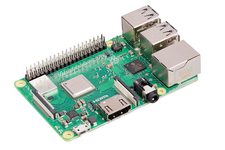RFID reader on a Raspberry Pi
Counting Pumpkins

© Lead Image © raspberrypi.com
Inexpensive components for the SPI interface let you upgrade a Raspberry Pi 4 to a display system for zero-contact RFID-based data acquisition.
Radio-frequency identification (RFID) tags have become indispensable in industry and government, as well as the wholesale and retail spaces. The inexpensive transponder chips can be found on clothing labels, identification cards, and credit cards. Armed with just a Raspberry Pi and an RFID kit, you can read the data from these chips and view it on a display.
In this project, I read serial numbers from RFID tags stuck on 3D-printed pumpkins – a slightly different kind of detection task. To do this, I connect an RC522 [1] RFID kit and a 1.8-inch ST7735 serial peripheral interface (SPI) thin-film transistor (TFT) display [2] to a Raspberry Pi 4. Together, the two modules can cost less than $15 (EUR15, £14) in online stores. The pumpkins contain simple RFID tags [3], also available for very little cash. Although at first glance the project seems clear-cut and sounds as if it should work right away, check out the "Mishaps, Misfortunes, and Breakdowns" box to find out what can go wrong.
The circuit diagram in Figure 1 shows how the modules connect to the Raspberry Pi, along with two pushbuttons and LEDs for testing purposes. The KiCad layout of the project is included in the download section of this article [4].
[...]
Buy this article as PDF
(incl. VAT)
Buy Linux Magazine
Subscribe to our Linux Newsletters
Find Linux and Open Source Jobs
Subscribe to our ADMIN Newsletters
Support Our Work
Linux Magazine content is made possible with support from readers like you. Please consider contributing when you’ve found an article to be beneficial.

News
-
Zorin OS 18 Hits over a Million Downloads
If you doubt Linux isn't gaining popularity, you only have to look at Zorin OS's download numbers.
-
TUXEDO Computers Scraps Snapdragon X1E-Based Laptop
Due to issues with a Snapdragon CPU, TUXEDO Computers has cancelled its plans to release a laptop based on this elite hardware.
-
Debian Unleashes Debian Libre Live
Debian Libre Live keeps your machine free of proprietary software.
-
Valve Announces Pending Release of Steam Machine
Shout it to the heavens: Steam Machine, powered by Linux, is set to arrive in 2026.
-
Happy Birthday, ADMIN Magazine!
ADMIN is celebrating its 15th anniversary with issue #90.
-
Another Linux Malware Discovered
Russian hackers use Hyper-V to hide malware within Linux virtual machines.
-
TUXEDO Computers Announces a New InfinityBook
TUXEDO Computers is at it again with a new InfinityBook that will meet your professional and gaming needs.
-
SUSE Dives into the Agentic AI Pool
SUSE becomes the first open source company to adopt agentic AI with SUSE Enterprise Linux 16.
-
Linux Now Runs Most Windows Games
The latest data shows that nearly 90 percent of Windows games can be played on Linux.
-
Fedora 43 Has Finally Landed
The Fedora Linux developers have announced their latest release, Fedora 43.

